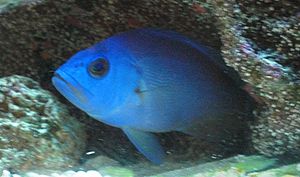Blue hamlet facts for kids
Quick facts for kids Blue hamlet |
|
|---|---|
 |
|
| Conservation status | |
| Scientific classification |
The blue hamlet (Hypoplectrus gemma) is a beautiful fish that lives in the ocean. It's a type of ray-finned fish, which means it has fins supported by bony rays. This fish belongs to the same family as groupers and anthias, called Serranidae. You can find blue hamlets in the western part of the Atlantic Ocean. Sometimes, they are also kept in aquariums.
Contents
What Does the Blue Hamlet Look Like?
The blue hamlet has a body that is quite deep and flat from side to side. Its forehead is straight, and it has a short snout. The upper part of its mouth can stick out.
Its fins are very important for swimming. The fin on its back, called the dorsal fin, has ten strong spines and 14 to 17 soft rays. The fins on its belly, called pelvic fins, are long and can reach past its anus. Its tail fin, or caudal fin, is slightly forked, like a shallow "V" shape.
The most striking thing about the blue hamlet is its color! Its whole head, body, and fins are a shiny, iridescent blue. It also has a black stripe along the top and bottom edges of its tail fin. The biggest blue hamlet ever recorded was about 13 centimeters (5 inches) long.
Where Do Blue Hamlets Live?
Blue hamlets live in the western Atlantic Ocean. For a long time, people thought they only lived around Florida in the United States. However, they have since been found in other places too.
They have been seen off the Yucatán Peninsula in Mexico. They also live near the island of Bonaire in the Dutch West Indies. You can also find them in the northern Bahamas and around Cuba.
Blue Hamlet's Home and Habits
Blue hamlets like to live on shallow coral reefs. They are usually found at depths of about 3 to 20 meters (10 to 65 feet).
These fish are special because they are hermaphrodites. This means that each fish has both male and female reproductive parts. When they are ready to spawn (lay eggs), they can switch between acting as a "male" or a "female."
Scientists have noticed something interesting about the blue hamlet's appearance. Its blue color and body shape look a lot like another fish called the blue chromis (Chromis cyanea). Some scientists think the blue hamlet might be mimicking the blue chromis. Mimicry is when one animal looks like another to gain an advantage.
Why would it do this? One idea is that by looking like the blue chromis, the blue hamlet might be able to get closer to young blue chromis and eat them. However, this idea still needs to be proven.
The blue hamlet is a carnivorous fish. This means it eats other animals. Its diet includes other small fish and small creatures that live on the seafloor, like crustaceans (such as crabs and shrimp).
How Blue Hamlets Were Discovered
The blue hamlet was first officially described in 1882. Two American scientists, George Brown Goode and Tarleton Hoffman Bean, gave it its scientific name. They found the first specimens of this fish near Garden Key in the Dry Tortugas, Florida. These scientists were ichthyologists, which means they studied fish.
Blue Hamlets in Aquariums
Blue hamlets are sometimes kept in home aquariums. It's not clear if they are a common or rare fish in the aquarium trade.


